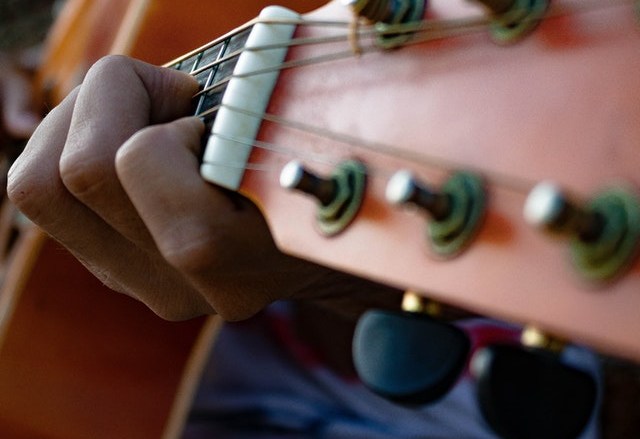
Open minor chords play a huge roll in guitar playing. Even though there really are just three common minor open chords, you should consider them to be among the most important for you to learn. Let’s take a close look at each of these three open minor chords.
What are minor chords?
Minor chords are the most important variation of the major chord in music. All minor chords share the 1st and 5th degree of the major scale with the corresponding major chord. But instead of including the 3rd degree as major chords do, minor chords contain the flatted 3rd degree of the major scale. This flattened note gives minor chords their characteristic melancholy or moody sound. In relation to the minor scale, a minor chord consists of the 1st, 3rd, and 5th degree.
In more practical language, you can play any major chord on guitar, but move the finger that plays the third of that major chord down one fret. When you do this, you flatten the 3rd degree. That flatted 3rd degree turns major chords into minor chords. And it works for any major chord as long as you can move the major third down one fret.
Need help understanding major chords?
It’s easier than you think to learn how to play a chord on guitar
Don’t understand the minor scale?
Like the minor scale, minor chords contain a more melancholy quality than major chords. Songs that use them as the primary chords tend to have an overall more sad or moody feel.
How to play three critical minor chords
Five major chords have very important open-chord fingerings on the guitar. By contrast, only three minor chords have comfortable open-position fingerings. But those three minor chords play a critical role in music.
Not fluent with open major chords?
Let’s learn those three minor chord shapes now. You’ll find each of them comfortable and easy to find and play. Especially if you know their major-chord counterparts.
Open E minor
In addition to being an extremely important chord, the open E minor chord might just be the easiest common full chord to play on the guitar. It requires just two fingers to play. And both of those fingers land in the same fret on adjacent strings.
And, if you know the open E major chord, making the open E minor chord simply requires you to lift one finger off of the fretboard.

Let’s first take a look at the open E major chord. Recall that you can use all six strings with this chord. It contains three E notes and two B notes.
But notice that it contains only one G#. You play that with your first finger on fret 1 of the G string. Remember that G# is the third degree of the major scale.
As we discussed, to turn a major chord into a minor chord, flatten the third degree. So, to make an open E minor chord, just lift your pointer off of the G string. This transforms the G# into a G.

You can see from this then that an E minor chord consists of the notes E, G, and B. To make it clear, in order to play an open E minor chord, press the A string at fret 2 with your middle finger for a B note. Then press the D string at fret two with your ring finger for an E note. Leave the two E strings, the G string, and the B string open.
Notice that this chord includes four open strings. This makes the chord one of the fullest, richest chords you can play on the guitar. Open strings add a definite richness to open chords, so having four of them really sweetens the pot.
This chord shape is also very important because when you incorporate it as a bar (barre) chord, it becomes a very simple movable shape that enables you to play every minor chord possible. It just depends upon where on the neck you play the shape. We’ll talk more about bar chords in another article.
Open A minor
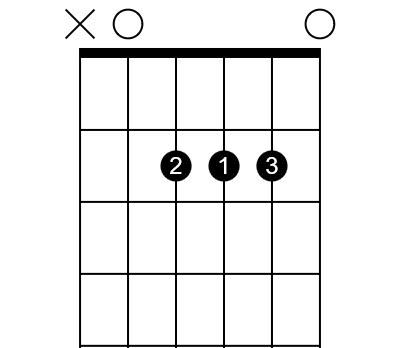
The open A minor is another full and rich chord. Like its major counterpart, it uses five strings on the guitar and includes two open strings.
Let’s first consider the open A major chord. Recall that this chord uses a fingering that at first feels awkward.
Making the open A minor chord requires a bit of finger shifting. Unlike the E minor chord, you can’t just lift a finger to make A minor.
But there’s still good news because the chord uses a shape that you’ll be familiar with and it’s easy to make and comfortable to hold.
To make open A minor, leave the A and High E strings open. Press the D string at fret 2 with your middle finger for an E note. Then press the G string at fret 2 for an A note.
Finally, the A major chord contains a C# note on fret 2 of the B string. That C# is the third degree of the major scale, so that’s the note we need to flatten in order to create the minor chord. To do this, press fret 1 of the B string with your pointer for a C note.
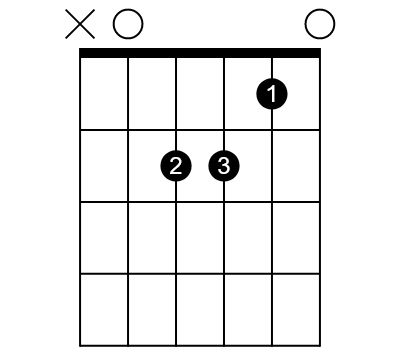
So, an A major chord consists of the notes A, C#, and E. In contrast, the A minor chord consists of the notes A, C, and E.
Notice something very interesting about the A minor chord. It uses identical shape and fingering to the E major chord. So, once you know and can comfortably play the E major chord, just shift the entire shape up one string and you have A minor.
This makes the chord easy to remember, easy to make, and comfortable to play. Open A minor is another extremely common and useful chord, so it’s important to know how to play it.
Open D minor
The last of our open minor chords, the D minor, might not be quite as popular as the other two, but you still need to know it. Many songs use it.

Of the three open minor chords, this one requires the most effort to change from the fingering of the major version to the minor. D major consists of the notes D, F#, and A.
F# occupies the third degree of the major scale, so we need to flatten that note to create the D minor chord.
But you’ll find that simply attempting to slide your middle finger down a fret to flatten that note doesn’t work. Your fingers don’t comfortably move that way.
So, to turn this major chord into a minor chord, you’ll have to move your pointer and middle finger. As with the major chord, leave the D string open. Then, use your pointer to press fret 1 of the High E string for an F note. That’s the flatted third you’re after.
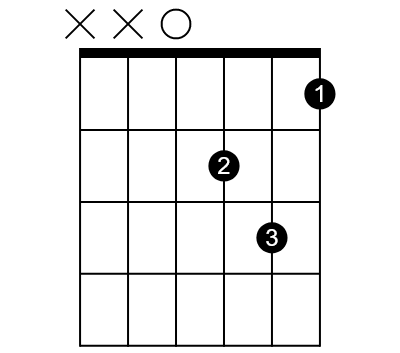
Use your middle finger to press the G string at fret 2 for an A note. With your middle finger, play the D note at fret 3 of the B string. Now you have your open D minor chord.
To summarize, the D minor chord consists of the notes D, F, and A.
While this shape might seem a little clumsy to get to at first, you’ll get used to it quickly. And once your comfortable with it, you’ll find it easy and comfortable to play.
This is a very important shape because it’s movable. This means you can move it to any fret up and down the neck to play a different minor triad. Don’t forget to omit the open D string when you start moving to different frets.
Not familiar with minor triads?
Where are the open C minor and open G minor chords?
In our discussion of open major chords referenced above, you learn five different open major chord shapes. But in this discussion, we have only three open minor chords. We’re missing G minor and C minor. Why?
Why no open G minor?
Take a look at the G major chord chart. The note B, the third of the chord, appears at both fret 2 of the A string and at the open B string.
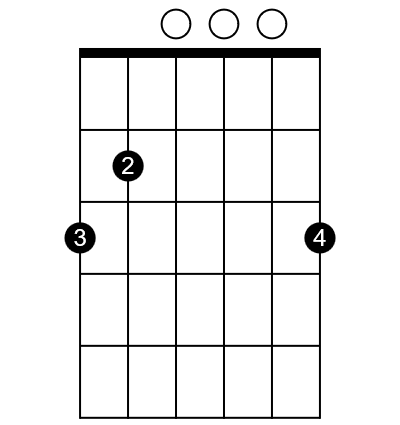
To make a G minor chord, you need to flatten the third. In this case, you need to flatten both instances of the B note.
With the fingering I suggest for G major, you can reasonably easily flatten the B on the A string. Use your pointer to play Bb at fret 1 of the A string.
But here’s where we run into problems. Since the other B in the G major chord results from the open B string, you have no way to flatten that note. You can’t include the note because then you won’t have a G minor chord. You’ll have something, but it’s not G minor.
You could mute the B string by touching it lightly with one of your fingers so that it doesn’t ring out. But this is pretty awkward to do because most of your fingers are busy. It’s possible, but not too comfortable or easy.
Another way you could play it is to leave the B and High E strings out completely and just play the four fattest strings. That gives you the notes G, Bb, D, and G. That’s a perfectly acceptable G minor chord, but it’s not a very common shape to play and lacks sparkle since it doesn’t include either of the high strings.
For these reasons, it’s not common to play an open G minor chord.
Why no open C minor?
The case of making an open C minor chord is even sticker than G minor. The notes of C major are C, E, and G. The major chord contains two E notes. Just like the G major, you can flatten one of those E notes, but the other occurs on an open string.
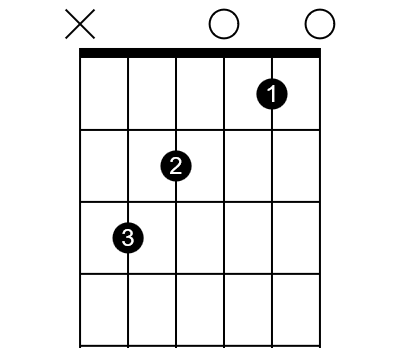
While you could flatten the E note on fret 2 of the D string to play an Eb, and thus create the minor chord, there is no comfortable fingering that enables that shape. You can do it, but it’s not easy.
And again, you’d have to mute or avoid playing the High E string since you have no way to flatten that note.
Again, these reasons account for the rarity of playing an open C minor chord in most pop-based styles of music.
Notice the similarities in the E minor, A minor, and D minor chords
An interesting aside delves into the physical characteristics of the guitar in standard tuning. It’s helpful to understand this to gain a more full understanding of your instrument.
Each of the three open minor chords we’ve learned here contains the first inversion of the minor chord. This points out that the three chords contain the same basic structure.
The appearance of the first inversion
In the case of the open E minor chord, the notes B, E, and G on the A, D, and G strings form that first inversion. The E minor chord, since it uses all six strings also contains a root position of the chord: E, G, B on the D, G, and B strings. Finally, a second inversion of the chord exists with the open G, B, and E strings.
The open A minor chord contains two of the inversions. A first inversion exists on the D, G, and B strings where you have the notes E, A, and C. The root position exists on the A, B, and E strings with the notes A, C, and E.
Finally, the open D minor contains only one inversion. That’s the first inversion on the G, B, and E strings with the notes A, D, and F.
So all three of them contain the first inversion of the minor chord.
Why don’t the shapes reflect this similar structure?
To answer that question, we have to keep the B-string exception in mind. The different interval tuning of the B string compared to the G string before it forces us to compensate in our fingering.
Don’t know about the B-string exception?
So the structure of these three chords is indeed identical. But the fingerings don’t match because you have to account for the B string’s tuning.
I’ll talk more about this in a future article. It’s not critical knowledge–you can play guitar without ever understanding it. But knowing these types of guitar relationships just gives you a better understanding of your instrument overall. And that can only help you be a better player.
When do you use minor chords?
The short, smug answer is that you use minor chords whenever they work for the song you’re playing or writing. But of course, there are a few points that will be more helpful than that, so let’s look at it a bit more closely.
Use minor chords in minor-key songs
It might seem obvious that in a minor-key song, you’re going to use a lot of minor chords. But there’s really more to it than just that.
True, the main chords of the song will most likely be minor chords if the song is in a minor key. But that doesn’t mean the song will you only minor chords. It will also potentially use major chords. And it’s not uncommon for minor-key songs to include chords that are neither minor nor major.
Use minor chords in major-key songs
In the same way that minor-key songs can include major chords, major-key songs often include minor chords.
Sometimes a minor chord is the expected and appropriate chord for the progression to proceed logically. Other times, a minor chord appears at an unexpected time in a progression and adds a different type of emotion to the overall piece.
You’ll quickly find you need other minor chords than the three open chords. To learn how to make them, read
How to turn guitar chords E minor and A minor into any other minor chord
In other words, mixing minor and major chords is sometimes completely expected. And other times the songwriter can use an unexpected minor chord to build some sort of emotion effect into the song.
Setting a mood with minor chords
In music, no absolutes exist when it comes to chord progressions. Certainly, some things are more expected than others. For instance, there’s little surprise when a progression moves from the 5th chord to the root chord.
But the old adage that rules are meant to be broken has never been more true than it is in music theory. And that’s how it is with minor chords.
Whether minor chords are used in the expected places or as interesting deviations from expectations, they are a powerful tool for the songwriter and guitarist. They enable you to lead the listener into different emotional spaces.
With minor chords you can set a different mood than that which you set with major chords. Ive mentioned several times that minor chords provide a more moody and melancholy emotional feeling.
It’s amazing how you as a player can manipulate the emotions of your listener. Perhaps “manipulate” is too harsh a word with negative connotation. But you really can guide your listener into new emotional territory with minor chords. Or at least you can help underscore the emotions they already feel.
Conclusion
Minor chords give the songwriter and the guitarist a powerful tool for creating emotionally impactful music. They have a more moody, melancholy sound that major chords.
Minor chords are closely related to major chords. In fact, the only different between the two lies in the chord’s third degree. While a major chord contains a natural third, minor chords contain a flattened third.
There are three common open minor chords. Those chords are A minor, E minor, and D minor. The three chords are closely related in a structural sense. They are also all very important chords in many genres of music.
While there are five common open major chords shapes, only three exist for minor chords.. There is no comfortable shape for either C minor or G minor.
Minor chords give you the power to enhance your listener’s emotional reaction. You can use them to lead your listener into a more emotional state of mind. Thus minor chords are very powerful and very useful for emotional music.

I want to learn more.
I’ll keep writing!